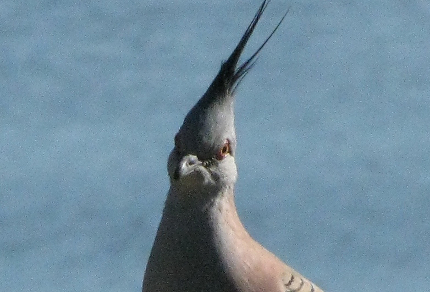
Crested Pigeon, Bundaberg, Queensland (© Vilis Nams)
While researching spinifex for yesterday’s post, I stumbled across two reports describing findings which indicate that Australia’s crested pigeon (one of two pigeons having crests in Australia, the other being the spinifex pigeon; hence the link to spinifex) employs a novel auditory defensive warning system. The warning sound is not produced by the bird’s vocal cords, but by its wings.
In flight, the wing feathers of crested pigeons produce a distinctive, high-pitched whirr that resembles a whistle and is very helpful for identifying this species. However, research done by Dr. Robert Magrath and student Mae Hingee of the Australian National University in Canberra has shown that the pigeons also produce a variation of the whirring sound which alerts other pigeons to the fact that danger is near.1,2
Crested pigeons feed on the ground, frequently in flocks. By observing feeding flocks, Magrath and Hingee noticed that the wing whistling seemed to change when birds flew off in alarm.1 They hypothesized that crested pigeons were using wing-created whistles as a defensive alarm to warn other crested pigeons of danger.1 To test this hypothesis, the researchers first recorded the wing whistles made by crested pigeons routinely flying away from flocks, and the whistles made by birds that blasted off in alarm when a hawk model was tossed at them from behind a blind.1
Analysis of the recordings showed that the routine and alarm flight whistles were ‘quite complex and distinct, each with two tonal elements and an atonal “clap”,’ but the alarm whistle was faster and louder than the routine flight whistle.2 When Magrath and Hingee played the recording of a routine flight whistle to 15 flocks of birds, the flocks continued feeding uncondernedly; however, when the researchers played the recording of an alarm flight whistle to the flocks, it was like a sentinel shouting, “Incoming!”1 For 80% of the flocks, the reaction to the alarm flight whistle was an instant abandonment of the feeding grounds, making it clear that the alarm whistle plays a significant role in the survival behaviour of crested pigeons.1 The ‘alarm’ wing whistle may, in fact, be the first instance of a flight noise being used as a warning of danger.2
References:
1. Asian News International. Aussie pigeons use feathers as predator alarms. 2-Sep-2009. © Al Bawaba (Middle East) Ltd. Accessed 8-Oct-2010. http://www.thefreelibrary.com/Aussie+pigeons+use+feathers+as+predator+alarms-a0207086355
2. The Free Library by Farlex. When a whistle beats a tweet. 1-Sep-2009. © 2009 AFP Global Edition. Accessed 8-Oct-2010. http://www.thefreelibrary.com/When+a+whistle+beats+a+tweet-a01611982930


